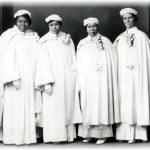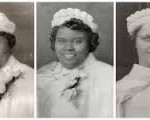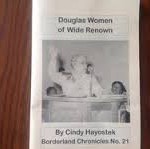This is one in another of my summer series on Pentecostal women, I am off for vacation till August, but in August, I hope to dedicate the next several installments commemorating the 70th anniversary of the death of Foursquare founder, Sister Aimee Semple McPherson.
One of the more intriguing stories I’ve included in my long-suffering attempt to finish my book on Pentecostalism in America is the one about Mother Rosa Horn. Horn founded her own denomination, the Pentecostal Faith Church, Inc., adopted a white woman as her daughter, ran a farm and fed thousands during the Depression. In keeping with the pacifist strain of early African American Pentecostalism, she served as an advocate for conscientious objectors when they appeared before draft boards, arguing for their ministerial exemptions. That few outside the specialized academic and pastoral circles have ever heard of this remarkable women says a lot about women’s histories receding to the background of the larger Pentecostal narrative of great men and women, and especially African American women, who have not received anywhere near the attention that they deserve
http://pfc-inc.org/founders.html
Mother Rosa Horn was born in Sumter, South Carolina in 1880, the granddaughter of slaves. In an interview Horn gave to the newspaper the Afro American in 1934, she filled in a bit of her family history. Her grandmother, Ellen Hamilton purchased her freedom and the freedom of her husband before Emancipation. Horn’s mother, Sarah Baker insisted that her children attend private school in Sumter. Horn married musician William Artimus, and Horn tells a fantastic story of escaping her husband’s attempt to kill her when he found out his tuberculosis was terminal. Described in the story as “love-sick” and near death with TB, Artimus tried to kill her by shooting her but “[The Lord] lifted her bodily from one chair to another,” with Artimus continuing to fire at her back. Several years after William died, Horn and her daughter Jessie found that they were sick with TB as well, and left Illinois to go back south to Georgia, where she joined a Methodist church and later began attending a Fire Baptized Holiness church, where she reported being healed of the TB. Horn and her daughter headed back north to Illinois and Indiana, where she was ordained by another pioneering Pentecostal woman, Maria Woodworth Etter in Indiana in 1913. Moving to establish her own ministry in Evanston, Illinois, Horn married again, a man named William Horn.
Several things in this story should give us pause. The physics-defying transportation of Horn from one place to another to escape bullets, echoes stories of teleportation in other religions, (I’m thinking of the superhero like powers of certain rabbis in Jewish mysticism, or the running monks in Tibetan Buddhism), in this case, God lifted her from one place to another. Since Pentecostal narratives are filled with these stories, this is perhaps not the most outlandish part of the story.
As Horn ministered during the 1930s in Evanston, Illinois, a white follower, possibly the father of Gladys Brandhagen, named Albert, asked Horn to pray that his daughter be healed of a chronic stomach ailment stemming from an untreated appendectomy. Gladys was healed as was her father, who suffered from chronic fatigue as a remnant of measles. In a different spin to that story that Gladys provided to an interviewer in 1985. In this interview, Brandhagen, originally from North Dakota, was brought to Illinois by her father, apparently as a last ditch attempt to save her from a life as a rebellious, sinful teenager. She does not mention her healing or her father’s healing, but instead focuses on the taming of her spiritual rebelliousness. The details of these two completely different stories describing Gladys’s reasons for moving to Evanston since in Pentecostal hagiography, what is important are the theological imperatives of healing and the diminishing of sin. Gladys had a remarkable career in her own right, working for her mom as musical producer during the church’s radio days in New York in the 1930s, and she later moved to Baltimore in the 1950’s and ran a church there till she died in 1992. From the scant records that I’ve been able to track down, the Horn family did not seem to make much of their adopting of a white woman, but there is little doubt that one of the reasons the Horn family and ministry stayed in Harlem, and eventually branched out to Baltimore, Philadelphia and the Bahamas, was that Northern cities would have been “safer” places for them to conduct their ministerial work during the Depression years.
Horn ministered in Evanston with her biological daughter Jessie, and her adopted foster daughter Gladys, who, in tandem, reported healings and resurrections that shocked the reporters of the Afro American when they claimed to have “raised a child from the dead.” The two women reported that they had been arrested three times over the course of their time in Evanston, but they did not mention why they had been arrested. The idea that an African American woman would “adopt” a white woman from North Dakota, and then they would both report the “grand slam” of all Pentecostal healings, resurrecting children in their church in Evanston, is an amazing narrative of how the urgency of belief in miracles overwhelmed, if for a short while, the nearly permanent racial barriers that existed and still exist in Pentecostalism.














